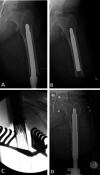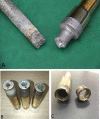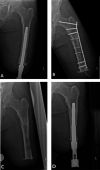What Are the Risk Factors for Mechanical Failure and Loosening of a Transfemoral Osseointegrated Implant System in Patients with a Lower-limb Amputation?
- PMID: 34889879
- PMCID: PMC8923606
- DOI: 10.1097/CORR.0000000000002074
What Are the Risk Factors for Mechanical Failure and Loosening of a Transfemoral Osseointegrated Implant System in Patients with a Lower-limb Amputation?
Abstract
Background: Septic loosening and stem breakage due to metal fatigue is a rare but well-known cause of orthopaedic implant failure. This may also affect the components of the osseointegrated implant system for individuals with transfemoral amputation who subsequently undergo revision. Identifying risk factors is important to minimize the frequency of revision surgery after implant breakage.
Questions/purposes: (1) What proportion of patients who received an osseointegrated implant after transfemoral amputation underwent revision surgery, and what were the causes of those revisions? (2) What factors were associated with revision surgery when stratified by the location of the mechanical failure and (septic) loosening (intramedullary stem versus dual cone adapter)?
Methods: Between May 2009 and July 2015, we treated 72 patients with an osseointegrated implant. Inclusion criteria were a minimum follow-up of 5-years and a standard press-fit cobalt-chromium-molybdenum (CoCrMb) transfemoral osseointegrated implant. Based on that, 83% (60 of 72) of patients were eligible; a further 3% (2 of 60) were excluded because of no received informed consent (n = 1) and loss to follow-up (n = 1). Eventually, we included 81% (58 of 72) of patients for analysis in this retrospective, comparative study. We compared patient characteristics (gender, age, and BMI), implant details (diameter of the intramedullary stem, length of the dual cone, and implant survival time), and event characteristics (infectious complications and distal bone resorption). The data were retrieved from our electronic patient file and from our cloud-based database and analyzed by individuals not involved in patient care. Failures were categorized as: (1) mechanical failures, defined as breakage of the intramedullary stem or dual-cone adapter, or (2) (septic) loosening of the osseointegrated implant.
Results: Thirty-four percent (20 of 58) of patients had revision surgery. In 12% (7 of 58) of patients, the reason for revision was due to intramedullary stem failures (six breakages, one septic loosening), and in 22% (13 of 58) of patients it was due to dual-cone adaptor failure (10 weak-point breakages and four distal taper breakages; one patient broke both the weak-point and the dual-cone adapter). Smaller median stem diameter (failure: 15 mm [interquartile range 1.3], nonfailure: 17 mm [IQR 2.0], difference of medians 2 mm; p < 0.01) and higher median number of infectious events (failure: 6 [IQR 11], nonfailure: 1 [IQR 3.0], difference of medians -5; p < 0.01) were associated with revision intramedullary stem surgery. No risk factors could be identified for broken dual-cone adapters.
Conclusion: Possible risk factors for system failure of this osteointegration implant include small stem diameter and high number of infectious events. We did not find factors associated with dual-cone adapter weak-point failure and distal taper failure, most likely because of the small sample size. When treating a person with a lower-limb amputation with a CoCrMb osseointegrated implant, we recommend avoiding a small stem diameter. Further research with longer follow-up is needed to study the success of revised patients.
Level of evidence: Level III, therapeutic study.
Copyright © 2021 by the Association of Bone and Joint Surgeons.
Conflict of interest statement
All ICMJE Conflict of Interest Forms for authors and Clinical Orthopaedics and Related Research® editors and board members are on file with the publication and can be viewed on request.
Figures









Comment in
-
CORR Insights®: What Are the Risk Factors for Mechanical Failure and Loosening of a Transfemoral Osseointegrated Implant System in Patients with a Lower-limb Amputation?Clin Orthop Relat Res. 2022 Apr 1;480(4):732-734. doi: 10.1097/CORR.0000000000002112. Clin Orthop Relat Res. 2022. PMID: 35020624 Free PMC article. No abstract available.
References
-
- Al Muderis M, Khemka A, Lord SJ, Van de Meent H, Frolke JP. Safety of osseointegrated implants for transfemoral amputees: a two-center prospective cohort study. J Bone Joint Surg Am . 2016;98:900-909. - PubMed
-
- Aschoff HH, Kennon RE, Keggi JM, Rubin LE. Transcutaneous, distal femoral, intramedullary attachment for above-the-knee prostheses: an endo-exo device. J Bone Joint Surg Am. 2010;92(suppl 2):180-186. - PubMed
-
- Bauchau OA, Craig JI. Euler-Bernoulli beam theory. In: Bauchau OA, Craig JI, eds. Structural Analysis . Springer Netherlands; 2009:173-221.
MeSH terms
LinkOut - more resources
Full Text Sources
Research Materials

